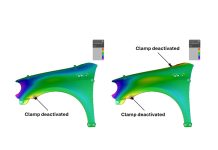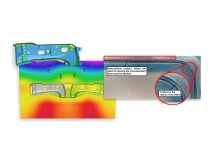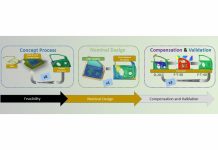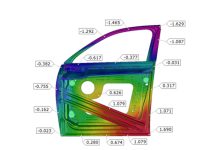Fifteen years ago, AutoForm introduced a novel idea to the sheet metal stamping industry: AutoForm-DieDesigner, a sheet metal simulation integrated-draw die-face development product. With this product, we upended a long-standing process engineering paradigm, where draw die-face concepts had to be meticulously surfaced in CAD prior to import and meshing for FEA analysis—a time-consuming and arguably sub-optimal process. For the first time, die-face development within the formability engineering environment allowed for rapid iteration and improvement cycles, reducing the time spent to develop tooling concepts while improving sheet metal quality and feasibility.
This paradigm shift created an entirely new work flow for stamping process method planning in which the engineering of the die face—die tip, binder curvature, addendum geometry—and process settings like draw bead configuration, blank shape, and binder force could truly be simultaneously engineered and validated. Starting with part data only, an addendum for draw and line die concepts are created, for immediate process validation and improvement when necessary. Rapidly iterating between die face creation and evaluation of the process engineering concepts, represented a significant improvement in engineering practices, enabling stamping process engineers to design optimized stamping processes. This shift—from a process using FEA simulation as a CAD design validation tool to one where simulation is used to drive die-face engineering—created a new challenge as well: “How do we efficiently transfer the feasible die-face concepts into fully faced CAD objects?”

Rapid DieFace development during process engineering necessitates recreation of CAD/CAM ready surfaces
With AutoForm-ProcessDesignerforCatia, our customers—like Fontana Pietro, whose success story we shared in an earlier post—rapidly recreate machinable surfaces based on their AutoForm-DieDesigner concepts. AutoForm-ProcessDesignerforCatia brings a new approach for rapid die face creation to the CATIA Environment, creating repeatable and reliable machine-ready die faces that translate directly to and from AF-ProcessExplorer for final validation and compensation.
AutoForm-ProcessDesignerfor Catia vs CATIA V5 in the hands of a veteran designer
When we launched our CATIA embedded die face tool several years ago, we met a natural amount of skepticism. Why introduce a CATIA add-on to perform tasks that many users already complete every day using native CATIA functions? CATIA V5 is a very powerful general-purpose solid modeler; however, it was not purpose built to make draw die development sheet solids, draw die addendum, or stamping die faces. The experience and creativity of the CATIA user would lead to highly variable results in die-face quality. ProcessDesignerforCatia introduces not only new modelling tools, but also a whole new approach specific to die-face design. It enables an entirely new approach for draw developments, a standardized workflow, and results that are more consistent.
The difference comes with the AutoForm-ProcessDesigner method, focused on creating the sheet-metal-forming die face. A new CATIA V5 user cannot master this unique task until many weeks or months after their initial training in the native CATIA utilities. With AutoForm-ProcessDesigner, we reduce the number of software operations accessed, streamline their access, and optimize the steps needed to complete the most common die-face creation tasks.

AutoForm-ProcessDesigner enables creation of fully parametric DieFace faster than native CATIA functions
To validate our approach, we conducted a head-to-head comparison of AutoForm-ProcessDesignerforCatia to CATIA V5 native functions. An external die engineering company created a die face using standard CATIA functions, applying decades of experience to create the draw die model based on a provided general development concept; developed part data, die tip, process plan, planned die layout sections, and intended binder shape. The desired output; the needed die surfaces created in CAD to match an already validated die concept. This represents a likely starting point if process engineering had been completed in AutoForm-DieDesignerplus and a CAD model was required for die solid creation and machining.
Given that level of input, die-face creation requires defining a press coordinate system (tipping), creating curved binder surface, un-trimming or extending the product surfaces, building the addendum section-by-section, and then joining and filleting all the surfaces needed. The part used for this case study was an automotive door-inner. The die face featured developed trim lines in a “laid-out” positon for secondary operations, a shallow pad formed area in the window opening, and complex draw bars in the header region and the hinge faces.
After roughly 40 hours, the engineering provider completed the draw development (shown on the right below). They reported more than 4,725 discrete commands in CATIA to complete the draw development. Note that this was primarily a surfacing exercise and presumed that engineering decisions like the process plan were already defined.

To fill the window opening AutoForm-ProcessDesigner required 4 steps, to create the same in CATIA required 20 steps
The complexity of the work is illustrated in the expanded portion of the feature tree above, which represents the design hierarchy for the window opening of the door panel. Using the native CATIA, the expert designers used more than 20 operations to generate the surface, while the AutoForm-ProcessDesigner development required only four commands to complete the surface definition. Many of the tasks to create the window opening have been automated.
Generally, any designer using AutoForm-ProcessDesigner would use the same four command functions to complete the window area and others like it. However, given the geometry using native CATIA functions, it is unlikely that every CAD designer would create the surface the same way. Some might creatively complete the surface with fewer commands; others might use more commands to complete a similar fill. Consistency of creating complex surfaces from designer to designer often causes issues with updates for part modifications or changes. With AutoForm-ProcessDesignerforCatia the streamlined and simplified method for creation of similar surfaces vastly improves consistency when updating and sharing designs.

transitions in radii and elevation angles through the areas highlighted in green , orange, and yellow patches
Further review of the development in native CATIA highlighted some challenges with quality of surface. Specifically, a few of the transitions through the draw bar in the hinge face appeared to be less than “class A”; this minor shortcoming in the detailing using native CATIA would likely need to be re-surfaced and further extend the required engineering investment in the die face.
In other areas, AutoForm-ProcessDesigner enables efficient creation of needed design elements, like developed flanges, that take into account the material characteristic and thickness in developing the flange. Without these capabilities, developed flanges are often created point by point, as a “best guess” by the designer based on the length of the final flange, often overlooking potential for material deformation. With ProcessDesigner, changes or updates to the flange development can be achieved by updating a single editing point, while with native CATIA such changes require multiple edits.

Developed flanges are defined simply in AutoForm-ProcessDesigner, while native CATIA requires point-by-point editing
AutoForm-ProcessDesigner enabled our engineers to create in only six hours what took a senior designer 40 hours to create using CATIA V5 native functions. When a new product release version was introduced to the completed development, AutoForm-ProcessDesigner achieved updates and revisions to the development in fewer than 15 minutes. The same update took more than 35 minutes in the native file, specifically in areas with developed flanges and newly replaced holes and features. If designers who did not create the initial surfaces must update designs created using ProcessDesigner, updates will work for all aspects created using the specialized features. With native-built geometry, updates are not always possible as no standardized method exists and it may not be evident how the initial surfaces were processed — ultimately requiring complete redesign of the surface.
It is clear from these results that ProcessDesignerforCatia and its novel methodology streamlines the creation of the machine-ready die face. It assures that investment and lessons learned in advanced feasibility, draw OP development, and process engineering are effectively converted into machine-ready tool surfaces in the most efficient manner.














Great informative piece, Thank you!